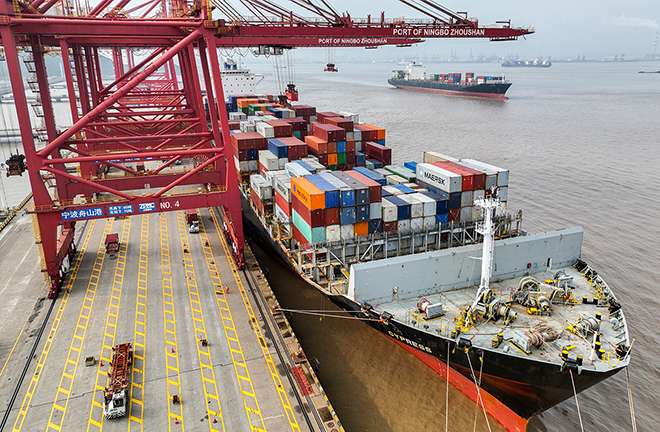Fostering new bidirectional direct investment model

A containership destined for B&R countries at the Port of Zhoushan, Zhejiang Province, June 6 Photo: CFP
Against the background of economic globalization, enterprises reconfigure the global layout of production activities in the form of outward direct investment (ODI), according to the comparative advantages of each region to maximize their own interests. It is vital to accelerate the construction of a new development paradigm, and to fully shape the bidirectional direct investment system in China, to allow Chinese industries to move to the middle and high end of the Global Value Chains (GVCs).
Development opportunities
From the practical experience of China’s economic development, bidirectional direct investment represents a new opportunity to promote China’s upgrading in GVCs and the industrial chain layout.
First, the early policy of extensive investment introduction attracted an abundance of foreign surplus capital, which was combined with inexpensive Chinese labor. By improving production efficiency and industrial systems, China has gradually become the global manufacturing industry’s central hub, extending its value chains to many countries and regions. Next, the extensive introduction of investment allowed China’s manufacturing comparative advantages to concentrate in labor-intensive industries and the processing and assembly of capital- or technology-intensive industries, increasing domestic jobs and residents’ income levels, and solving the dilemma of China’s shortage of foreign exchange reserves. Finally, introduction of technology-intensive capital and technology-seeking ODI promoted the optimization and improvement of Chinese enterprises’ technology levels, management experience, and organization methods through technology spillover effects. This has provided reference for China’s manufacturing industry to strengthen, complement, extend, and expand value chains.
Although the extensive bidirectional investment policy has temporarily fueled the economy’s rapid development, it has also harbored hidden dangers of weak economic growth in later stages. First, part of the value chain—dominated by large multinational companies—began to shift to other countries. Second, a large number of low-end manufacturing industries in China have low value-added returns, which restricts enterprises’ R&D investment and leads to China’s manufacturing industry’s being stuck in the low-end of GVCs for too long. Once again, China’s ODI is still mainly resource-seeking, with less investment in high-end manufacturing and high-tech industries. This has led to weak absorption of reverse technology spillover, a slow upgrading process in GVCs, and an urgent need to optimize the structure of outward investment. Finally, the slow recovery after the 2008 global financial crisis has led to increasing unilateralism, trade protectionism, and an anti-globalization trend, which coupled with the COVID-19 pandemic, has caused a sharp slowdown in the pace of China’s ODI and hindered the process of GVCs’ restructuring.
Vital means
International direct investment reallocates factors of production and rare resources globally by directing capital flows, which is a vital means for a country to transfer its industries, upgrade its technologies, reconstruct its production advantages and thus upgrade its GVCs.
The foreign direct investment (FDI)’s technology spillover effect provides an important basis for host country enterprises’ technological upgrade and market competition structure selection. The FDI’s reverse technological spillover effect also provides support for home countries’ enterprises to upgrade industrial structures and GVCs.
Resource preferences
Upgrading in GVCs combines each link along a country’s whole industrial chain with the matching advantageous resources, and then promotes the optimization and improvement of the whole industrial chain. In response to different resource preferences made by international direct investment, we should guide investment to combine funding with corresponding resource advantages, to leverage the role of capital in promoting economic development and thus support upgrading in GVCs.
China should encourage foreign investment in technology-intensive industries to merge with talent, technologies, and industrial layouts in the east, guiding foreign investment in labor-intensive industries to shift to the central and western regions to couple with surplus labor in those regions. China should fully utilize foreign investment to drive local economic development, optimize the allocation of limited domestic resources, and then upgrade the overall domestic industrial chain.
China should actively use investment effects of the Belt and Road (B&R) initiative, encouraging production capacity and capital to go global. Capitalizing on the advantages of building the B&R by helping enterprises go global can improve domestic industrial layouts and structure an optimal allocation of resources. It can also help countries along B&R routes to improve their industrial basis and industrial systems, and build a “value chain system with multiple circulations,” with China as the core producer.
Managing relationships between ODI and FDI is central to China’s high-quality economic development. We should leverage the power of international direct investment to help boost China’s value chain upgrade.
Capital factors in international investment require frequent cross-border flows, and thus recipient countries’ institutional environment is a key factor affecting FDI.
In terms of the domestic institutional improvement process, the rule of law should continue to be steadily promoted. It should also introduce a penalty mechanism for legal violations, improve the mechanism for foreign enterprises to defend their investment rights, open up communication channels between foreign investors and local governments, and effectively and efficiently protect the rights and interests of foreign investors. Only by continuously improving government efficiency and transparency can the institutional cost of investment be gradually reduced, improving the market’s efficiency of resource allocation and promoting the optimization of industrial structure and high-quality economic development.
In summary, by changing the preferences of capital factors, optimizing industrial layouts, and enhancing institutional guarantees, China’s bidirectional investment should fully leverage technology spillover effects, reverse technology spillover effects, and demonstration effects, to achieve a continuous upgrading in GVCs, based on high-tech industries and driven by innovation.
China should optimize the structure of bidirectional investment, and drive the improvement and upgrade of the domestic industrial chain system by attracting high-quality foreign investment and promoting high-tech outward investment.
Huang Xinfei is a professor from the International School of Business and Finance at Sun Yat-sen University.
Edited by ZHAO YUAN
